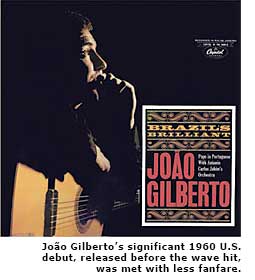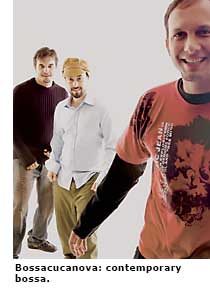Bossa Nova: Music of Modern Love - Page 3
There was bossa also in the brand-new soundtrack written by Jobim, de Moraes, and Luiz Bonfá for the film version of 'Black Orpheus,' a co-production of France, Italy, and Brazil. Picking up awards at Cannes and at the Oscars, the movie spawned several bossa hits and helped spread awareness to the outside world in 1959, not only of bossa but also the samba-enredos of Carnaval and the rituals of macumba.
Musical visitors to Brazil, chief among them jazz guitarist Charlie Byrd, began bringing home news of bossa. By the end of 1960, Capitol Records had released the album 'Brazil's Brilliant João Gilberto' to delighted Americans.
An American jazz festival staged in Rio and São Paulo in 1961 brought in American jazz flautist Herbie Mann, who'd already acquired Brazilian tastes from expatriate pianist and accordionist João Donato. Jazz, as we've seen, had inspired bossa with its innovative but sophisticated approach to harmonic arrangement. Now jazz was reaping a return on its investment, replete with samba rhythms and tropical ease of delivery.
By 1962, the term bossa nova was in common use in Brazil, bolstered by a new crop of what would be the genre's classics tunes, created by Jobim, Jorge Ben, Roberto Menescal, Baden Powell, and others. But as 'nova' as some of this may have seemed at the time, not everything about the music was totally new. Some purveyors of older styles, like the singer Lucio álves, simply adopted, or let themselves be adapted to, the new style. The national affinity for vocal groups, earlier modeled by postwar American singers, extended to closely harmonized bossa by such groups as Os Cariocas.
Among the tasty new tunes served up to bossa performers and their fans was a paean written by Jobim and Moraes to a young woman they'd regarded, repeatedly, passing the Veloso bar, one of their favorite vistas in Ipanema for contemplating real-life and imaginary muses. Aside from the aspects and objects of carnal love celebrated in their 'Garota de Ipanema,' bossa lyrics (particularly in the original Portuguese) proclaimed affection for place ('Corcovado') and for the felicities of life itself ('A Felicidade,' and 'Aguas de Março' or 'The Waters of March').

Interest in the genre abroad justified the staging of a concert at New York's Carnegie Hall in November 1962, billed as 'Bossa Nova (New Brazilian Jazz),' and hosted by jazz critic Leonard Feather. The performers included Jobim, Gilberto, Menescal, Bonfá, Carlinhos Lyra, Oscar Castro-Neves, and Sérgio Mendes.
A few days later, in the same city, Jobim and Gilberto met with producer Creed Taylor and saxophonist Stan Getz to discuss a follow-up to Getz's earlier flirtations with Brazilian sounds, showcased on the album 'Jazz Samba,' and inspired in large part by Charlie Byrd. On the sessions for the 'Getz/Gilberto' album, in March of 1963, Gilberto's wife Astrud insisted on providing vocals, in English, for 'Garota de Ipanema,' translated as 'The Girl From Ipanema.' When released the following year, this song became one of Brazil's biggest and longest-lasting cultural exports.
Despite some skepticism in the mother country about bossa's destiny, many new singers embraced the genre, while some already associated with bossa pursued their fortunes abroad. Although the Gilbertos' marriage was dissolving, Astrud toured with Getz and recorded her own popular albums, singing mostly in English; and João rejoined the saxophonist in 1964 for 'Getz/Gilberto #2.'
 On the other side of North America, Sérgio Mendes took up residence in California and a place on the charts with his Brasil '66 vocal group, showcasing both bossa originals and bossa-izations of other people's pop hits. Luiz Bonfá and pianist-arranger Eumir Deodato also fared well in the American recording industry, at a time when more and more fans and fellow musicians were waxing curious about their approach.
On the other side of North America, Sérgio Mendes took up residence in California and a place on the charts with his Brasil '66 vocal group, showcasing both bossa originals and bossa-izations of other people's pop hits. Luiz Bonfá and pianist-arranger Eumir Deodato also fared well in the American recording industry, at a time when more and more fans and fellow musicians were waxing curious about their approach.
Notable among the curious was one of Brazil's long-loved idols, Frank Sinatra, who brought his favorite Brazilian composer to California to record the album 'Francis Albert Sinatra & Antonio Carlos Jobim,' in 1966. Sinatra sang with appropriate tender restraint, and the album was sufficient proof that bossa had moved into a permanent place in American popular culture. (For many fans of that disc, and of the earlier efforts of Getz and the Gilbertos, that place was right next to the sofa, or the bed; this was paradigm make-out music.)




